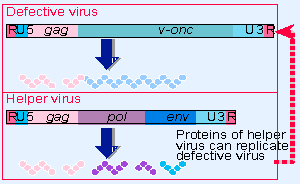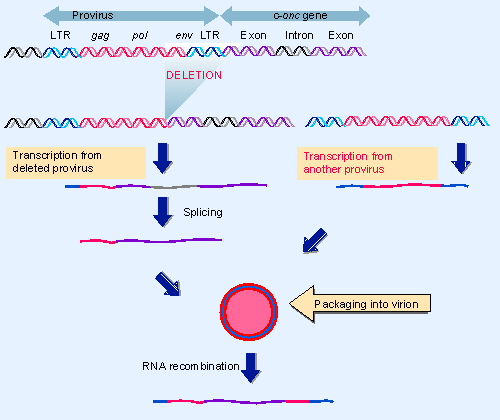3. Retroviruses may transduce cellular sequences
16.3 Retroviruses may transduce cellular sequences |
| Key terms defined in this section |
| Helper virus provides functions absent from a defective virus, enabling the latter to complete the infective cycle during a mixed infection. |
 |
Figure 16.10 Replication-defective transforming viruses have a cellular sequence substituted for part of the viral sequence. The defective virus may replicate with the assistance of a helper virus that carries the wild-type functions. |
An interesting light on the viral life cycle is cast by the occurrence of transducing viruses, variants that have acquired cellular sequences in the form illustrated in Figure 16.10. Part of the viral sequence has been replaced by the v-onc gene. Protein synthesis generates a Gag-v VOnc protein instead of the usual Gag, Pol, and Env proteins. The resulting virus is replication Vdefective; it cannot sustain an infective cycle by itself. However, it can be perpetuated in the company of a helper virus that provides the missing viral functions.
Onc is an abbreviation for oncogenesis, the ability to transform cultured cells so that the usual regulation of growth is released to allow unrestricted division. Both viral and cellular onc genes may be responsible for creating tumorigenic cells (see 28 Oncogenes and cancer).
A v-onc gene confers upon a virus the ability to transform a certain type of host cell. Loci with homologous sequences found in the host genome are called c-onc genes. How are the onc genes acquired by the retroviruses? A revealing feature is the discrepancy in the structures of c-onc and v-onc genes. The c-onc genes usually are interrupted by introns, but the v Vonc genes are uninterrupted. This suggests that the v-onc genes originate from spliced RNA copies of the c-onc genes.
 |
Figure 16.11 Replication-defective viruses may be generated through integration and deletion of a viral genome to generate a fused viral-cellular transcript that is packaged with a normal RNA genome. Nonhomologous recombination is necessary to generate the replication-defective transforming genome. |
A model for the formation of transforming viruses is illustrated in Figure 16.11. A retrovirus has integrated near a c Vonc gene. A deletion occurs to fuse the provirus to the c-onc gene; then transcription generates a joint RNA, containing viral sequences at one end and cellular onc sequences at the other end. Splicing removes the introns in both the viral and cellular parts of the RNA. The RNA has the appropriate signals for packaging into the virion; virions will be generated if the cell also contains another, intact copy of the provirus. Then some of the diploid virus particles may contain one fused RNA and one viral RNA.
A recombination between these sequences could generate the transforming genome, in which the viral repeats are present at both ends. (Recombination occurs at a high frequency during the retroviral infective cycle, by various means. We do not know anything about its demands for homology in the substrates, but we assume that the nonhomologous reaction between a viral genome and the cellular part of the fused RNA proceeds by the same mechanisms responsible for viral recombination.)
The common features of the entire retroviral class suggest that it may be derived from a single ancestor. Primordial IS elements could have surrounded a host gene for a nucleic acid polymerase; the resulting unit would have the form LTR Vpol VLTR. It might evolve into an infectious virus by acquiring more sophisticated abilities to manipulate both DNA and RNA substrates, including the incorporation of genes whose products allowed packaging of the RNA. Other functions, such as transforming genes, might be incorporated later. (There is no reason to suppose that the mechanism involved in acquisition of cellular functions is unique for onc genes; but viruses carrying these genes may have a selective advantage because of their stimulatory effect on cell growth.)